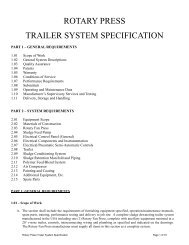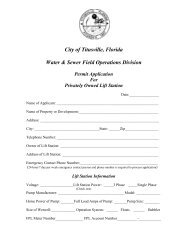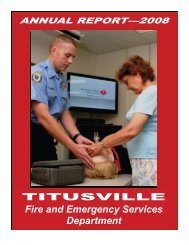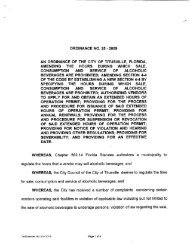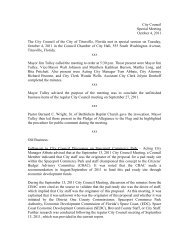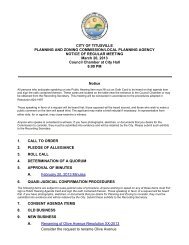annual report-2009.pdf - The City of Titusville, Florida
annual report-2009.pdf - The City of Titusville, Florida
annual report-2009.pdf - The City of Titusville, Florida
Create successful ePaper yourself
Turn your PDF publications into a flip-book with our unique Google optimized e-Paper software.
Q: What does “chain <strong>of</strong> survival” mean<br />
A: “Chain <strong>of</strong> Survival” is a phrase used to describe the<br />
protocols that have been instituted to improve the survival<br />
rate <strong>of</strong> patients suffering from significant medical<br />
emergencies.<br />
<strong>The</strong> chain begins with basic life support measures provided by citizens on the scene <strong>of</strong> the emergency, such as<br />
Citizen CPR. <strong>The</strong> next in the chain is rapid emergency medical intervention by trained emergency responders with<br />
advanced equipment, followed by rapid emergency transport to a hospital that can initiate additional life saving<br />
procedures and measures.<br />
Q: “When I make an emergency medical call via 911, why do I have<br />
both a fire truck from <strong>Titusville</strong> and an ambulance from Brevard<br />
County show up<br />
177 community<br />
members<br />
were taught<br />
Citizen CPR<br />
in 2009<br />
Community Blood Pressures<br />
Checked in 2009:<br />
1,615<br />
Our department provides blood<br />
pressure checks at every fire<br />
station. In addition, on Sunday<br />
mornings from 10-11 a.m., we<br />
staff 4 community locations to<br />
provide this free health service<br />
throughout our community.<br />
A: <strong>Titusville</strong>’s fire trucks carry advanced life support equipment<br />
and licensed paramedic personnel. Our arrival on scene is 3 or<br />
more minutes prior to that <strong>of</strong> Brevard County’s ambulance<br />
units. This provides a more immediate response to a medical<br />
emergency.<br />
This question is asked <strong>of</strong> us frequently. <strong>The</strong> answer is simple in<br />
content, but complex in nature.<br />
Today, when the caller is in need <strong>of</strong> assistance—from cats in trees to<br />
severe trauma and sudden death from cardiac or stroke-related<br />
emergencies—911 is dialed. <strong>Titusville</strong>’s four strategically placed fire<br />
stations (with a total <strong>of</strong> five ALS units) and firefighters licensed and<br />
trained in advanced life saving skills are able to provide a more rapid,<br />
expertly skilled crew response to any emergency location within the city<br />
<strong>of</strong> <strong>Titusville</strong> in under 5 minutes.<br />
By design, this rapid “first responder” ability <strong>of</strong> applying advanced life<br />
support at the earliest opportunity is statistically proven to result in<br />
improved outcomes from patients suffering from cardiac, stroke and<br />
trauma. This rapid implementation <strong>of</strong> pre-hospital patient care in the<br />
“chain <strong>of</strong> survival” protocol is a substantial factor in why TFES had a<br />
28% patient survival rate from sudden cardiac arrest in 2009 versus the<br />
national average <strong>of</strong> 3% - 5% (based on the new AHA 2010 estimations).<br />
In addition, our city’s Community CPR training program, initiated last<br />
year in partnership between our department and Parrish Medical<br />
Center, provides the earliest possible on-scene basic life support<br />
benefit to the cardiac patient. Citizen CPR intervention coupled with<br />
advanced components such as defibrillation, drug therapies and<br />
advanced airway skills (as provided by ALS first responder units) meets<br />
the American Heart Association stance on pre-hospital survival<br />
success.<br />
13



